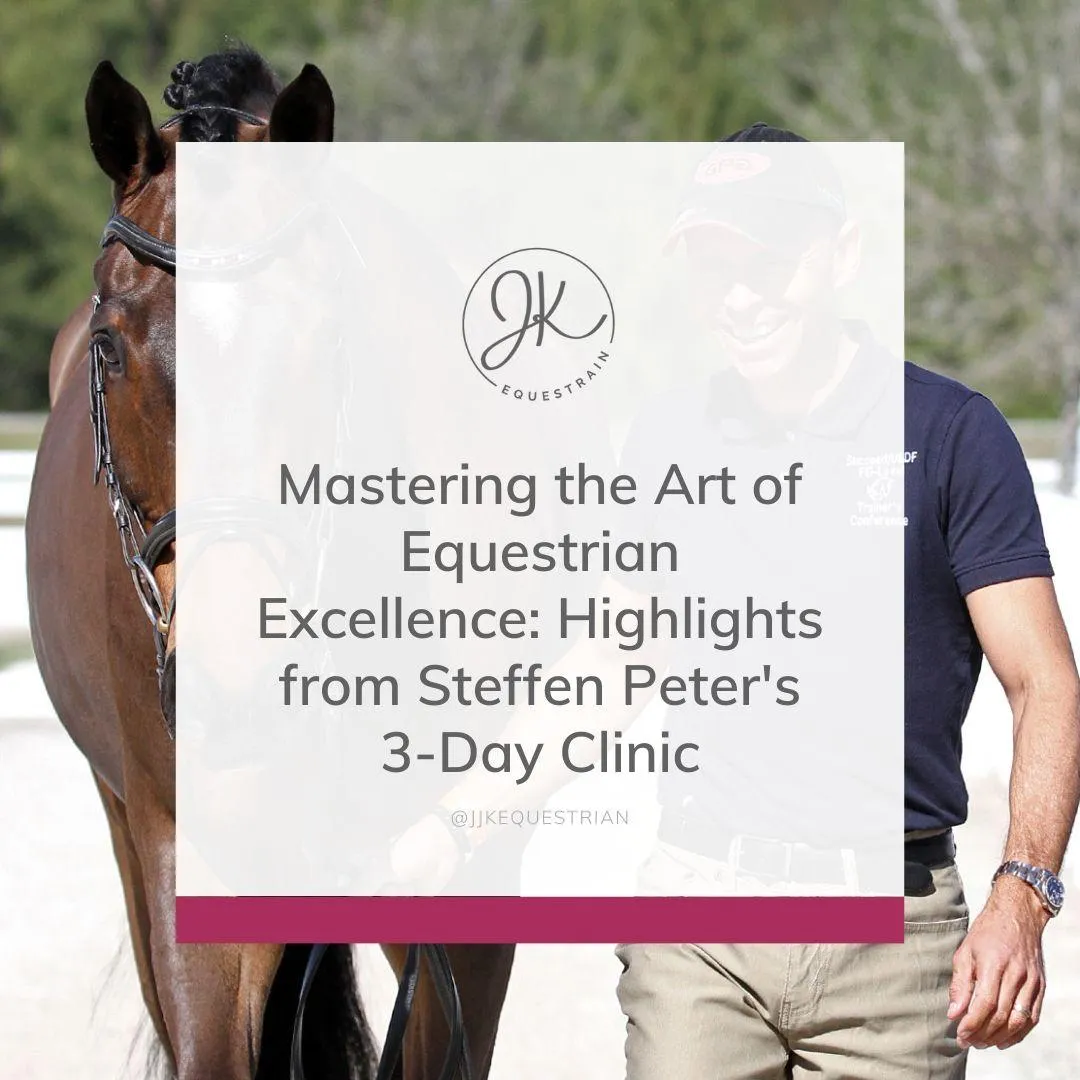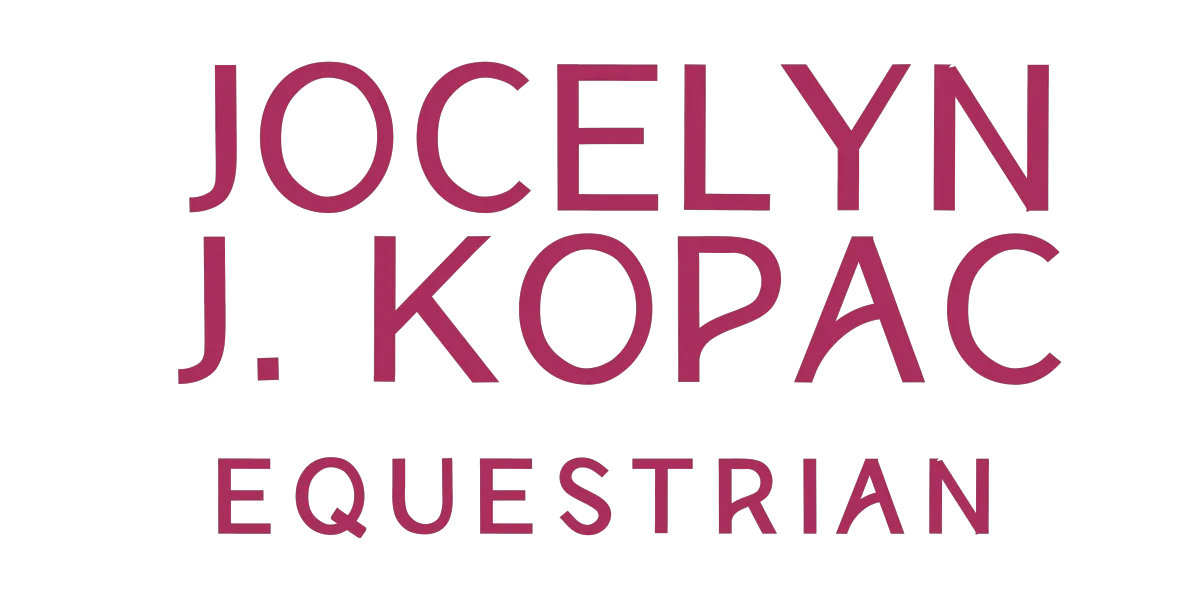JJK Equestrian Blog
Where Passion Meets the Saddle

Insights from a 3-Day Steffen Peter's Clinic and Talk at Midwest Horse Fair
Over the course of three days at the Midwest Horse Fair, attendees were treated to a wealth of wisdom from Steffen Peters. From training rides to master class talks, Peters shared invaluable nuggets of knowledge aimed at refining the art of horsemanship.
What Is Midwest Horse Fair?
The Midwest Horse Fair in Madison, Wisconsin, served as the backdrop for a transformative three-day experience under the guidance of renowned equestrian expert, Steffen Peter. Participants were treated to a series of clinic/training sessions and a master class talk, each brimming with invaluable insights to elevate their horsemanship. Here, we delve into the key takeaways and nuggets of wisdom shared throughout this immersive journey.
Who is Steffen Peters?
Steffen Peters is a name synonymous with excellence in dressage training. With a career spanning decades, Peters has honed his craft to perfection, guiding riders towards harmony with their equine partners. His approach emphasizes not just technical proficiency but also the cultivation of a deep connection between horse and rider, a philosophy that resonates profoundly with those seeking to elevate their horsemanship to new heights.
Key Takeaways: Steffen Peter's Dressage Clinic
Listen to the blog here:
Embracing Flow:
Peter's teachings emphasized the importance of relinquishing control and surrendering to the natural rhythm of the horse-human partnership. Drawing inspiration from "Untethered Soul" by Michael A. Singer, riders were encouraged to shed limiting beliefs and embrace a mindset of openness and receptivity. By letting go of preconceived notions, riders can tap into a state of flow, or "the Zone," where harmony and synchronicity prevail.
Optimal Conditioning Strategy:
Peter advocated for a strategic approach to conditioning, emphasizing the importance of alternating between high-intensity intervals and periods of rest. Riders were advised to push their horses to perform at peak intensity for 2 to 5 minutes, followed by a brief respite to allow for recovery and adaptation. This interval training protocol promotes cardiovascular fitness, muscular endurance, and overall conditioning, ensuring that horses are primed for peak performance.
Strategic Planning:
In the realm of equestrian training, Peter underscored the significance of meticulous planning and timing. It's not just about knowing what needs to be done but also when to execute each element of the training regimen. By adhering to a structured timeline and sequencing training tasks effectively, riders can maximize their horse's progress and development. This strategic approach ensures that training efforts are purposeful, systematic, and conducive to long-term success.
Emotional Goal Setting:
Beyond mere visualization, Peter emphasized the importance of imbuing training goals with emotion and intention. It's not enough to envision success; riders must cultivate a deep-seated emotional connection to their objectives. By infusing goals with passion, determination, and purpose, riders can harness the power of motivation to propel themselves and their horses towards achievement. This emotional resonance serves as a driving force, fueling perseverance and commitment throughout the training journey.
Optimizing Half Pass Technique:
During the half pass maneuver, Peter offered nuanced guidance on rider positioning and weight distribution. Riders were instructed to shift their weight onto the inside leg, anchoring their weight in the inside heel for optimal balance and alignment. By redistributing weight in this manner, riders can facilitate greater engagement and collection, enhancing the fluidity and precision of the half pass movement.
Precision in Halting:
In pursuit of perfection, Peter stressed the importance of dedicating time to practicing halting square. This fundamental exercise serves as a cornerstone of obedience and discipline, requiring meticulous attention to detail. Riders were urged to focus on achieving square, symmetrical halts, ensuring that the horse remains balanced and composed. Through consistent practice and refinement, riders can cultivate a seamless transition from movement to stillness, demonstrating mastery and control.
Managing Self, Not Stress:
A recurring theme throughout the clinic was the notion that one can only manage oneself, not external stressors. Riders were urged to cultivate self-awareness and emotional resilience, recognizing that true empowerment lies in mastering one's reactions and responses. By adopting an attitude of inspiration over desperation, riders can navigate challenges with grace and composure.
The Art of Freestyle Planning:
For those venturing into the realm of freestyle dressage, Peter offered invaluable guidance on crafting a winning routine. Central to this process is the concept of BPM (beats per minute), wherein riders align their choreography with the tempo of the trot and canter.
Non-Negotiables in Training:
Two pillars emerged as non-negotiables in the realm of equestrian training: connection and leg aids. Peter underscored the importance of maintaining a consistent connection with the horse's mouth, fostering harmony and responsiveness. Similarly, riders were reminded to uphold the integrity of their leg aids, avoiding compromise for optimal communication and refinement.
Redefining Straightness:
Contrary to conventional wisdom, Peter challenged riders to transcend the confines of arena walls and embrace true straightness. Rather than relying on physical barriers, riders were encouraged to cultivate straightness through internal alignment and engagement. By anchoring weight in the inside heel and eschewing wall dependency, riders can unlock newfound levels of balance and alignment.

Diagnostic Riding Techniques:
In the pursuit of mastery, riders were urged to employ diagnostic riding techniques to uncover training gaps and weaknesses. From practicing square halts to evaluating the horse's self-carriage through heel pressure, riders gained invaluable insights into their equine partner's strengths and areas for improvement.
Harnessing Flexibility and Suppleness:
Peter emphasized the critical role of flexibility and suppleness in achieving optimal performance. Riders were encouraged to incorporate varied flexion exercises, transitioning seamlessly between inside and outside flexion to promote suppleness and responsiveness. By prioritizing bend and engagement, riders can unlock their horse's full athletic potential.
Mastering Transitions:
Central to effective communication is the mastery of transitions, from posting trot to sitting trot, walk to halt, and beyond. Peter underscored the importance of maintaining impulsion and connection throughout each transition, ensuring seamless flow and momentum. By honing these fundamental skills, riders can cultivate precision and finesse in their rides.
Counter Canter Clarity:
Dispelling common misconceptions, Peter redefined the purpose of counter canter as a mental exercise rather than a gate-enhancing tool. Riders were challenged to engage their horse's mind, fostering balance and coordination while maintaining the lead. By reframing counter canter as a cognitive challenge, riders can elevate their horse's mental agility and responsiveness.
The insights gleaned from Steffen Peters' clinic and talk at the Midwest Horse Fair serve as guiding lights for equestrians on their journey towards excellence. By embracing principles of connection, mindfulness, and purposeful training, riders can forge deeper bonds with their equine partners and unlock new levels of performance. As we continue to learn and evolve in our horsemanship, let us heed Peters' wisdom and strive for harmony, grace, and understanding in our pursuit of equestrian mastery.
Copyright ⓒ Kopac Enterprises LLC | 2024
Powered By TDMFunnels

